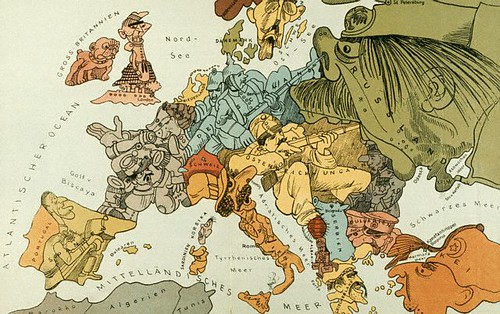

These images were done by the artist Philip Guston in the latter 1960s. Philip Guston was a painter/print marker with a cartoonish style whose work spanned form the abstract expressionism to the Neo- expressionism. One of Philip’s more famous series is his rendering of the KKK. This is one of those cartoons that rides the line between awful and funny, or rather is funny because it deals with the edge between comic and terrifying.
I picked these images because I though it was a good example of how his style and image, and not the word choice, created the ironic message Guston was looking for. His thick lines, meaty looking hands, and solid blocks of color render the KKK, a hate group, as cartoonish. This rendering has the effect of taking a very serous, feared, and in certain cases revered hate group and degrades both their importance as well as capability of creating any sort of effect. It makes the members look clumsy, clownish, imbecilic, almost cute, which dulls the sting one experiences on contemplating their name. One wonders if the one on the left’s thick hand (who appears to be doing a self portrait) could possible do an accurate rendering of himself. Surly, he is not sensitive enough to see himself in any sort of accurate light, never mind having the skill to create an accurate drawing out of the image in his head. One doubts if he has any meaningful message to convey, all his options must be one-sided, unrehearsed, based on faulty evidence. It is ridiculous and almost funny that he is trying to define and share himself with the rest of the world, rather than revolting and terrifying. It lessens both the weight of the Ku Klux Klan’s impact, and the gravity of their opinions.
The image on the right, which depicts three rock-like heads of the KKK members has a similar effect on the viewer. The stone-like heads look immobile, static, stationary, bolder-like, and dull. Not only does the image of rocks cause one to think of dense, stubborn, but it also makes the group look immobile and stuck. There is no way they are going to change despite the evidence thrown at then that contradicts their views. They are no longer sensitive human beings, but dumb rocks, symbols of an even dumber cause. For some reason there is almost noting more infuriating than a person who won’t budge despite opposing evidence of their views. The audience may become angry and dissatisfied as the static heads. It also causes the audience to doubt the capability of the groups ability to reek havic, for the stones (and these are particularly soft looking stones) can be thrown by human hands but they can’t grow legs and get up and walk along of their own accord, without additional support they are useless.
 This Venezuelan cartoonist/ illustrator works for MAD magazine creating caricatures and scences from famous movies putting a satirical twist on them, characteristic of the magazines fashion.
This Venezuelan cartoonist/ illustrator works for MAD magazine creating caricatures and scences from famous movies putting a satirical twist on them, characteristic of the magazines fashion.











































